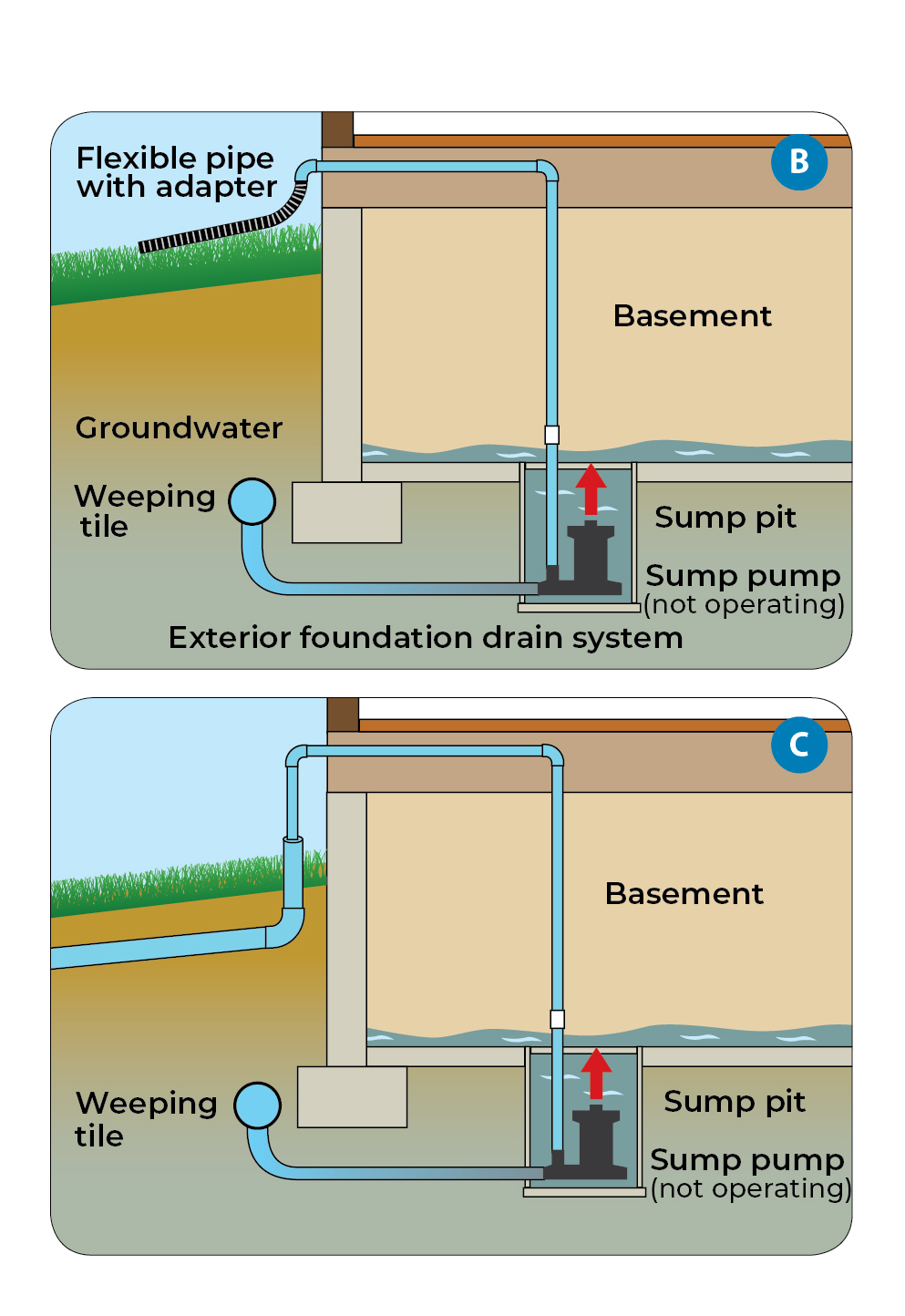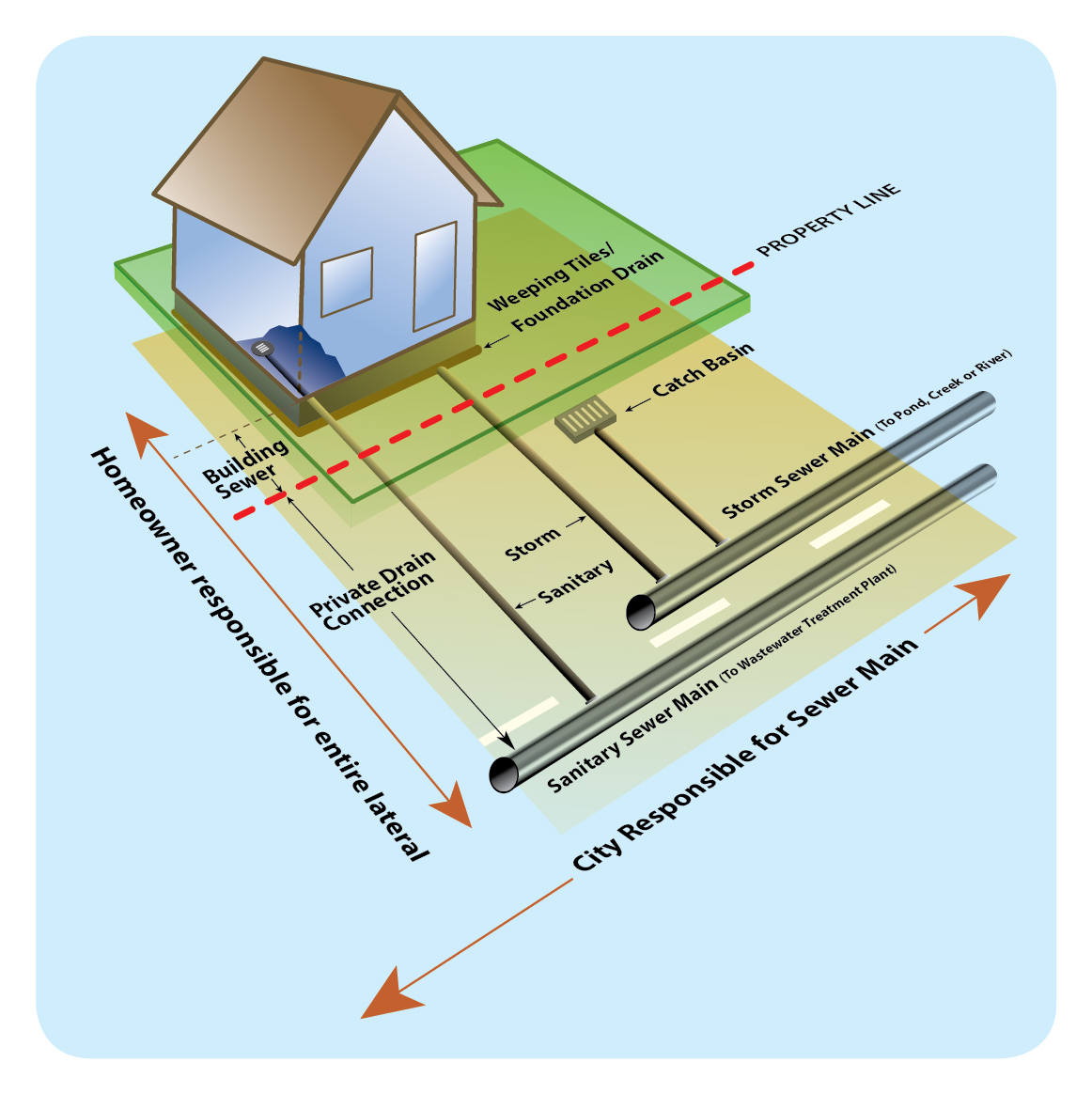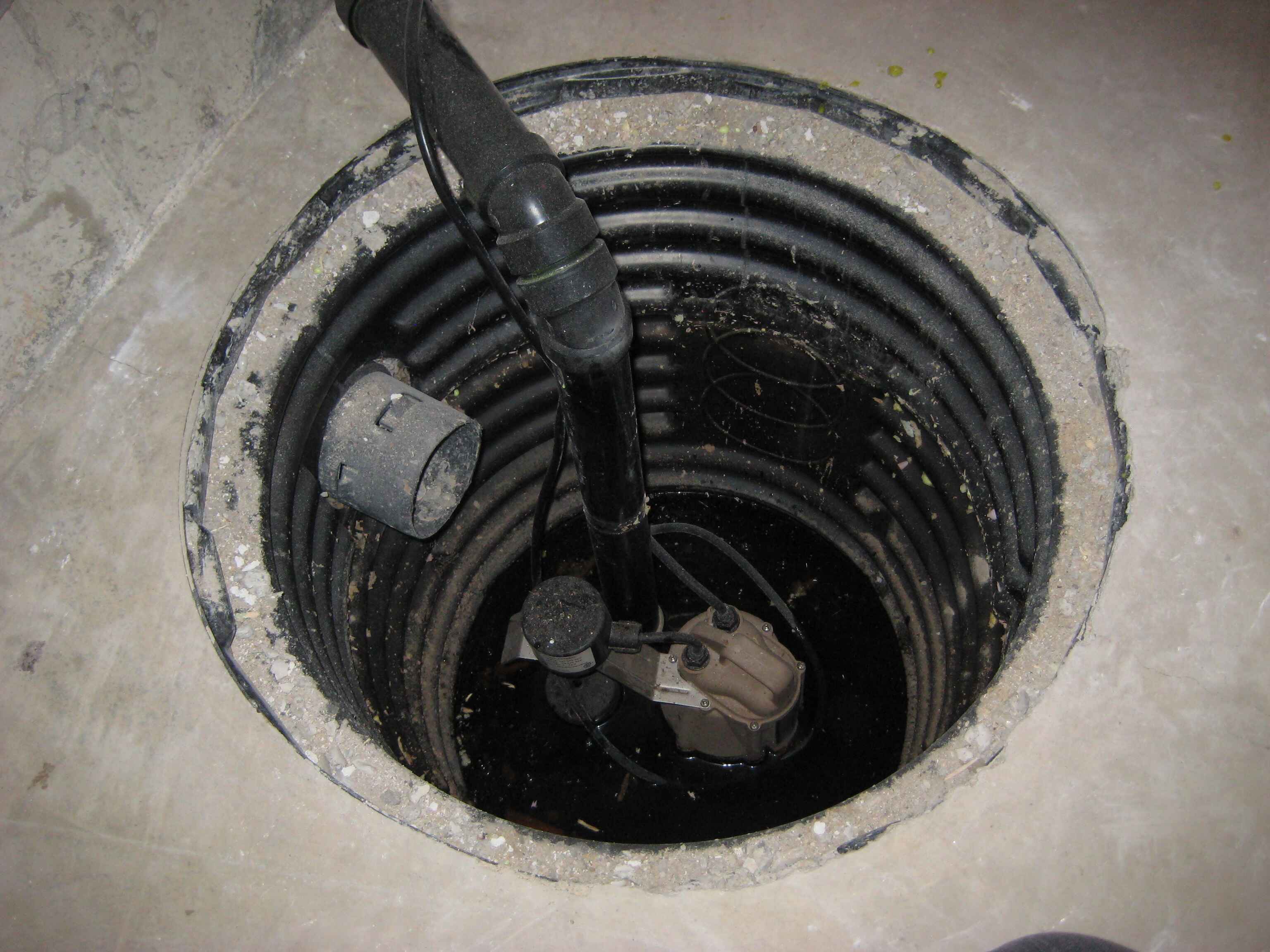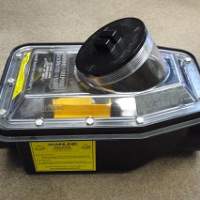What to do if your basement is flooding
- Do not enter your basement if the water has come into contact with any of the following: electrical outlets, baseboard heaters, furnace, electrical panel. For more information on flood safety, please visit the Electrical Safety Authority website.
- Call London Hydro's Emergency Line (519-661-5555) immediately to disconnect power to your home.
- Call your home insurance company.
- Once hydro is shut off, remove the water. This may require the assistance of a wet basement contractor and or restoration company.
- Contact the City of London to report basement flooding (519-661-4570). The City will inspect the municipal sewer system to ensure it is functioning as designed.
- Contact a licensed plumber or wet basement company. They will be able to give insight to the cause of the flooding.
Report basement or yard flooding
What causes basement flooding?
Basement flooding can be caused by different things. The following four cases describe common flooding situations that can occur in London homes:
Weeping tiles and/or downspouts connected to the sanitary sewer
During heavy rainfall, excessive rainwater may reach the roof downspouts and excessive groundwater may enter the weeping tiles. If your weeping tiles are connected to the sanitary pipes, this may overload the sanitary sewer capacity and cause a backup of sewage or stormwater into your home.

Solution - Disconnect weeping tiles and downspouts from the sanitary sewer system
Rainwater and groundwater should NOT enter the sanitary sewer system (Figure A). Have a licenced plumber/drainage contractor disconnect your weeping tiles from the sanitary sewer system. Disconnect your downspouts to ensure by-law compliance. Have a licenced plumber/drainage contractor install a sump pit and pump and backwater valve. The sump pump will direct the weeping tile groundwater to the ground surface or to the storm sewer system.
Be sure to properly maintain your backwater valve and sump pump for the best level of protection.
A malfunctioning sump pump
A malfunctioning sump pump is a sump pump that is not operating correctly or has stopped working causing your basement to flood (Figure B or C). Some common issues that can cause a sump pump to malfunction include:
- power failure
- stuck float switch
- clogged inlet or discharge pipe
- pump overload
- mechanical failure
- lack of maintenance

Solution - Maintain your sump pump and consider installing a battery back-up
Ensure that your sump pump is properly operated and maintained. If your sump pump has malfunctioned in the past, consider having it replaced or having a replacement pump on hand. Consider having a sump pump battery back-up system installed to allow a back-up sump pump to operate during a power outage.
Surface water causing basement flooding
Basement flooding can occur when there is water ponding around your foundation walls and/or your weeping tiles are not working or are non-existent. This results in excessive pressure against the foundation (Figure D).

Solution - Smart landscaping
Check that the ground around your house is sloping away from your foundation wall. This reduces the possibility of water entering through basement windows and/or cracks in your foundation or overloading the weeping tiles. Installing window wells around foundation windows will also reduce the possibility of water entering your basement.
Direct your downspouts away from your home, preferably 1.8 m (6 ft), where water can be easily absorbed, such as your lawn or flower bed while not forcing water on to neighbouring or city property.
If you are experiencing foundation cracks or floor cracks, contact a licensed plumber or drainage contractor to identify the preferred solution for your home.
City sanitary sewer pipe full or blocked sanitary lateral
If the City’s sanitary sewer pipe is full due to large amounts of rainwater from various sources – such as weeping tiles or overland flow – then sewage may back up into the basement (Figure E).
A home’s sanitary lateral may be blocked due to an obstruction, such as accumulated fats, oils and greases or tree roots. Sewage may then back up into the basement (Figure F).

Solution - Use flood-preventative devices and determine the cause of the blockage
Homes prone to flooding should each have a sump pit and sump pump and a sanitary backwater valve to prevent rainwater or sewage from backing up into the basement. Talk to a licensed plumber about the best way to flood-proof your basement before any device is installed. Each installation is different and some devices require a plumbing permit. Be sure to obtain multiple estimates/quotes.
The sanitary lateral can be inspected by a licensed plumber to locate the blockage and clear it. The homeowner is responsible for the condition and maintenance of the entire length of their sanitary lateral. The lateral may require lining or replacement.
Preventing basement flooding
The Basement Flooding Grant Program
The Basement Flooding Grant Program is designed to provide financial assistance to property owners who experience basement flooding. The program aims to help mitigate and prevent basement flooding incidents by offering funding for eligible flood protection measures.
Qualifying homeowners may receive grants to cover a portion of the costs to disconnect their weeping tiles from the City’s sanitary or storm systems and redirect them to a a new sump pit and sump pump. The program also provides financial assistance for backwater valves and sump pump battery back-ups. By doing this, property owners are decreasing their risk of basement flooding. These improvements can help reduce the risk of water entering basements during heavy rainfall or sewer backups.
Understanding drainage around your home
Properly taking care of your home and yard can help prevent basement flooding, moisture issues, and structural damage in the future. There are many different sources of basement flooding. Cracks in the foundation, plugged toilets and blocked sewer drains are the most common reasons homes flood.
Review the information below to better understand how water drains from in and around your home.

Sanitary (wastewater) sewer – The sanitary sewer receives wastewater from toilets, bathtubs, sinks, and laundry machines through your home’s pipes. The sanitary sewer is located under the street and is connected to the nearest sewage treatment plant.
Storm (rainwater) sewer – The storm sewer is located under the street. It carries surface water from lawns and streets, as well as groundwater from weeping tiles, to local streams.
Weeping tiles
Weeping tiles are pipes with perforations located underground around the basement foundation. When it rains, water filters into the ground. These pipes capture this water and take it away from the foundation walls to prevent groundwater from entering the basement. Weeping tiles may also be referred to as foundation drains or perimeter drains.
In newer homes built after 1985, weeping tiles are connected to a sump pit and sump pump. The water is then either pumped to the storm sewer or discharged to the yard.
In some older homes built before 1985, weeping tiles are generally connected to the sanitary sewer system with some exceptions. The City of London would like to remove all the rain water, groundwater and snow melt from the sanitary sewer system.
For further questions or to find out if you qualify for the Basement Flooding Grant Program, please contact sewers@london.ca or call 519-661-2489 x 5489.
Sump pit and pumps
A sump pit is located below your basement floor and collects groundwater from the weeping tiles. The sump pump moves the water from the sump pit to the ground surface or to the storm sewer.

Most homes in London constructed after 1985 have a sump pit and sump pump in their basement. A sump pump is a pump that is used to protect the basement from flooding by removing water from around the basement foundation. A sump pit is located below your basement floor and collects groundwater from the weeping tiles. The sump pump moves the water from the sump pit to the ground surface or to the storm sewer.
When it is raining, it is typical for your sump pump to run more often.
Sump pumps should not discharge to the sanitary sewer system.
Discharging a sump pump to your yard
If your sump pump discharges to the yard there are a few things to consider.
- Similar to downspouts from your eaves trough, the sump pump discharge should be directed away from your house, preferably 2 meters (6 feet) from the wall of the house to a grassed area.
- Ensure that the lot grading around the house is sloped away from the home to decrease the risk of the making its way back into the weeping tile system or directly into the basement.
- Keep in mind that the discharge should not negatively impact neighbouring properties, including City property to comply with the Drainage Bylaw WM-4.
- Do not discharge your sump pump to the sidewalk or driveway. During the winter months the sump pump can still regularly discharge water to the ground surface. When the water is directed towards sidewalks and driveways, it will freeze and could be dangerous to anyone walking across it.
Battery back-up
There is a possibility that during a thunderstorm the hydro to your home may be interrupted or unavailable. Having a battery back-up system for your sump pump will allow the pump to run for a limited amount of time when hydro is not available.
Secondary sump pump using City water
Some residents and businesses may have elected to install a secondary sump pump through a connection to the City’s potable water supply in their homes. The control valves that operate the secondary pumps should be checked from time to time to ensure they are working correctly. Some residents have had incidents where large amounts of tap water have passed through the sump and out into the storm sewer or across their lawns. This water has also passed through the water meter and they are then charged for the water and required to pay the bill.
Setting the float
The sump pump will have a device on it called the float, to let it know the level of water in the sump pit. When the float reaches a predetermined level, the sump pump starts and pumps the water out of the pit. The trick is to set the level of the float high enough so your pump isn't running all the time but low enough to be able to handle the water entering the pit. It may take a few tries to get it where you want.
Test your sump pump
It is a good idea to regularly test your sump pump, especially if it does not run very often or not at all. Take a bucket of water and slowly dump it into the sump pit. The sump pump should turn on when the float reaches a predetermined level. If the sump pump does not come on, "trip" the float to see if it comes on.
Backwater valves
Have you ever had water come up your floor drain in your basement? A sanitary backwater valve is a device that helps prevent sewage from backing up into your basement from the City’s sanitary sewer. The backwater valve automatically closes if sewage backs up from the sanitary sewer. Regular cleaning of the backwater valve is the responsibility of the homeowner.
How does a backwater valve work?
One type of backwater valve has a flap inside it that allows water to flow out of your home, but if water begins to flow into your home, this flap raises blocking the flow from coming into your basement. There are other acceptable approved valves that also prevent flow from backing up into your basement. Different valves are suited to different installations.

If your weeping tiles are connected to the sanitary sewer system you must disconnect the weeping tiles prior to installing a backwater valve.
Checking your backwater valve when it is raining
Check your backwater valve when it is raining outside to see if it is closed. If it is closed, do not use your plumbing in the house, have a shower, or flush the toilet. If the valve is closed, it prevents water from backing up into your home, but it also prevents water from leaving your home too. Wait until the valve is open again before using any plumbing in the house.
Maintaining a backwater valve
Regular cleaning of the backwater valve is the responsibility of the homeowner. It is recommended you follow the backwater valve manufacturer's guidelines and recommendations for maintenance of your backwater valve.
Yard flooding
It is normal to have some water on your property during a rain or snow melt event. This water is typically referred to as stormwater. The most important thing is to ensure water isn’t coming into your basement. Standing water on your own property can occur for several different reasons, soil type, lot grading, time of year, intensity of the rain event and any changes that have occurred on the property that have reduced green space.
Flooding caused by a neighbour
A flooding concern between two or more property owners is a civil matter and the city cannot intervene, it is up to the property owners involved to resolve the issue. The City of London is not responsible for flooding concerns between property owners. If you feel your neighbour(s) has caused flooding on your property, it is suggested that you discuss the concern with your neighbour to come up with a solution that benefits all property owners involved.
Maintaining lot grading
Lot grading helps ensure that rain and snow melt flow away your home, and other buildings on your lot. Proper lot grading can prevent ponding of stormwater and reduce the likelihood of damp basements and yards. New subdivisions (generally homes build after 1980) were designed with a lot grading plan which helps direct stormwater.
It is the property owner’s responsibility to maintain their own lot grading. There are several things you can do to ensure your property continues to have good drainage:
- Maintain swales and catchbasins as originally designed.
- Ensure there is a 2% slope away from your foundation.
- Keep swales and catchbasins free of obstructions.
- Talk with and consult with your neighbours about any work you plan to do that could impact drainage in any way.
- Consult an expert prior to starting any project that could potentially impact drainage.
- Get a copy of your lot grading plan from the City to help you with the layout of your project.
Practices to avoid:
- Discharging water from the roof, foundation or yard directly onto walkways, stairs or adjacent properties.
- Filling a swale with anything that could alter the flow of water (e.g., concrete, asphalt, rocks, soil or woody plants and trees).
- Raising or lowering the grade of your yard. Changing the grade of your yard could potentially impact the flow of water on your and neighbouring property.
- Building raised gardens or patios that could potentially impact the flow of water.
- Using materials that prevent surface water from soaking into the ground.
To improve yard drainage, consider restoring lot grading, install a rain garden, install a French drain or soak away pits, or contact a drainage contractor to help with drainage issues.
Catchbasins
Stormwater is collected by catchbasins and drains into the Thames River without prior treatment. When chemicals, oils and waste are disposed down a catchbasin, it can harm our rivers and creeks. Only rain should go down the drain.
Maintaining rear yard catchbasins
Rear yard catchbasins found in backyards are generally the responsibility of the homeowner to maintain. They are typically at the low point of the property and possibly take flows from multiple properties. In order to have your rear yard catchbasin function properly, please keep grass, weeds, debris, leaves and leaves from blocking the catchbasin cover. Ensure the area is sloped towards the catchbasin. During an intense rain event, a catchbasin in the road can pond up to 0.3m and a catchbasin in a rear yard can pond up to 0.45m. Once the storm subsides the stormwater will slowly drain away into the storm sewer.
How you can help
- If the catchbasin is in your yard, ensure water can flow towards the catchbasin and it has not been blocked.
- Do not pour anything down the catchbasin.
- Do not put pet and yard waste down a catchbasin.
- Minimize the use of fertilizers and pesticides on your lawn or garden.
- Recycle and safely dispose of hazardous waste such as used oil, paint, paint thinners, and batteries.
- Use eco-friendly salt alternatives for melting ice and snow on your property.
- Do not release unwanted household fish, game fish, or aquarium pets into catchbasins or ponds.
- Drain pools and hot tubs only after they are free of chemicals and salt.
- Use a commercial car wash or wash your car on a grassy area of your property.
- Check that your vehicle is not leaking fluids.
